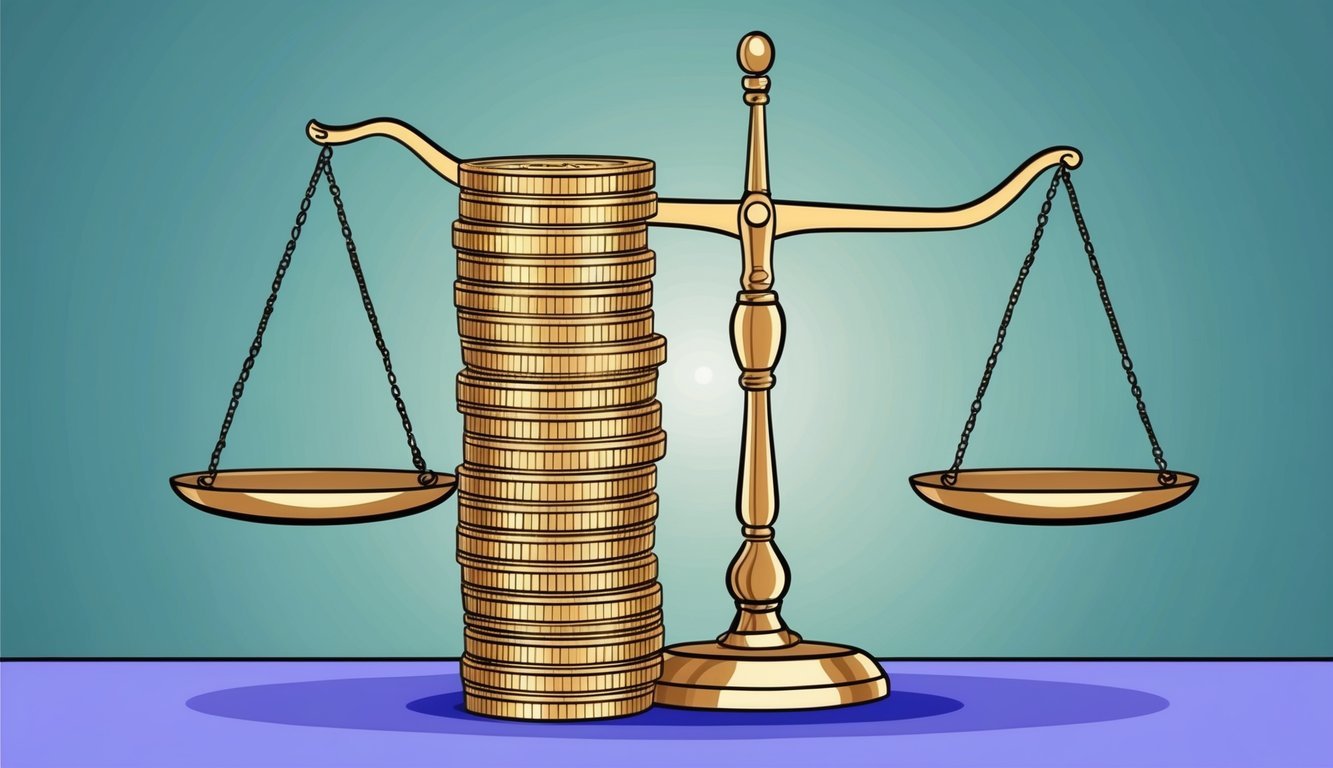Stablecoins are a special type of cryptocurrency that aims to keep a steady value. Unlike Bitcoin or Ethereum, which can change price quickly, stablecoins try to stay the same. They do this by linking their value to something stable, like the US dollar.

Stablecoins are designed to combine the benefits of regular money with the advantages of digital currencies.
You can use them to buy things, send money to friends, or save, just like you would with dollars. But they also let you move money fast and cheap, like other cryptocurrencies.There are different types of stablecoins. Some keep real dollars in a bank to back up their value. Others use smart computer programs to try and keep their price steady.
As more people use cryptocurrencies, stablecoins are becoming a big part of how digital money works. These digital assets offer a way to maintain value without the volatility typically associated with cryptocurrencies like Bitcoin and Ethereum. As individuals begin to consider the implications of their digital holdings, innovative solutions such as crypto estate planning strategies are emerging to ensure that these assets are safely passed on to future generations. By incorporating stablecoins into their financial planning, people can mitigate risks and effectively manage their digital wealth.
Key Takeaways
- Stablecoins aim to maintain a steady value by pegging to assets like the US dollar
- You can use stablecoins for everyday transactions and as a bridge between traditional and digital finance
- Different types of stablecoins exist, each with unique methods for maintaining stability
What Are Stablecoins?
Stablecoins are cryptocurrencies designed to maintain a steady value. They aim to solve the problem of price swings that many digital assets face. Let’s look at how they work and the different types you’ll encounter.
The Concept of Price Stability
Stablecoins try to keep their price fixed by tying it to something else. Often, this is a fiat currency like the US dollar. The goal is to make a digital asset that doesn’t go up and down in value all the time.
Why is this important? Well, it makes stablecoins more useful for everyday transactions. You wouldn’t want to buy coffee with a currency that might be worth half as much tomorrow!
Some stablecoins use other assets to back their value. These can include gold or even other cryptocurrencies. The key is to create a digital coin that keeps its worth steady.
Types of Stablecoins
There are a few main types of stablecoins you should know about:
- Fiat-backed: These are tied to regular money like dollars or euros.
- Crypto-backed: They use other digital assets as collateral.
- Commodity-backed: Think gold or oil as the backing.
- Algorithmic: These use computer programs to control supply and keep prices stable.
Fiat-backed stablecoins are the most common. For each coin, there’s supposed to be a real dollar in a bank account somewhere. This makes them easy to understand and trust.
Crypto-backed stablecoins are trickier. They often use extra collateral to protect against price drops. DAI is a famous example of this type.
How Stablecoins Maintain Value
Stablecoins use different methods to keep their value steady. These methods help them stay pegged to assets like the U.S. dollar or gold. Let’s look at two main ways stablecoins try to keep their price stable.
Collateralization
Collateralized stablecoins are backed by real assets. This means you can trust them to hold their value. For example, Tether (USDT) and USD Coin (USDC) are backed by U.S. dollars.
Here’s how it works:
- The company holds $1 in reserve for each coin they make.
- You can trade your stablecoin for real money anytime.
- They keep reserves of cash, bonds, and other safe assets.
Some stablecoins use other types of backing:
- Gold or silver (for commodity-backed coins)
- Other cryptocurrencies (like DAI)
These backings help keep the price steady. But remember, you need to trust the company to manage the reserves well.
Algorithmic Mechanisms
Algorithmic stablecoins work differently. They use smart contracts and math to keep their price stable. There’s no real asset backing them up.
Here’s how they try to maintain value:
- They increase or decrease the coin supply based on demand.
- When price goes up, they make more coins to bring it down.
- When price drops, they buy back coins to raise the price.
These coins can be riskier. They rely on complex systems and market forces. Sometimes they work well, but they can also fail if too many people sell at once.
You should be careful with algorithmic stablecoins. They’re newer and less tested than collateralized ones.
Stablecoins in the Cryptocurrency Ecosystem
Stablecoins play a key role in crypto trading and decentralized finance. They offer a steady value base for moving money and accessing financial services.
Trading and Exchanges
You’ll find stablecoins all over crypto exchanges. They’re often used as trading pairs with other cryptocurrencies like Bitcoin and Ethereum. This makes it easy to move in and out of different coins.
Stablecoins help you avoid price swings when trading. You can quickly switch to a stablecoin if the market looks shaky. This protects your value without having to cash out to regular money.
Many exchanges use stablecoins for deposits and withdrawals too. It’s faster and cheaper than using bank transfers. You can easily move stablecoins between different platforms.
Decentralized Finance (DeFi)
Stablecoins are the backbone of many DeFi services. You can use them for lending, borrowing, and earning interest.
When you lend stablecoins, you can earn steady returns without worrying about price changes. Borrowing with stablecoins lets you get a loan without selling your other crypto.
Some DeFi platforms let you stake stablecoins to earn rewards. This is like a high-yield savings account, but with crypto.
Stablecoins also make it easy to move money between different DeFi apps. You can quickly shift funds to take advantage of the best rates or new opportunities.
Regulatory and Systemic Considerations

Stablecoins face growing scrutiny from regulators due to their potential impact on financial systems. You should know about the key players involved and the risks they’re trying to address.
The Role of Regulators
Regulators aim to protect consumers and maintain financial stability. They’re looking closely at stablecoins like Tether (USDT) and USD Coin (USDC). These coins could affect traditional financial services.
You might wonder why regulators care. Well, stablecoins touch on several areas:
- Commodity laws (Are they a commodity?)
- Banking rules (How are they backed?)
- Securities regulations (Do they act like securities?)
Regulators want to create a legal framework that fits these new assets. They’re working on rules for how stablecoins should be managed and overseen.
Risks and Challenges
Stablecoins come with their own set of risks. You should be aware of these when using them:
Counterparty risk
: What if the company behind the coin fails?Market volatility
: Even “stable” coins can wobble.Backing concerns
: Are there really enough assets to support the coins?
Remember the TerraUSD (UST) crash? It showed how things can go wrong fast. The Luna token, meant to keep UST stable, couldn’t handle the pressure.
Decentralized stablecoins on blockchain face unique challenges. They need to balance stability with being truly decentralized. It’s a tough act!
Regulators worry about systemic risk. If a big stablecoin fails, it could hurt the whole financial system. That’s why they’re keen on oversight.
Frequently Asked Questions

Stablecoins are a hot topic in crypto. People want to know how they work and why they’re useful. Let’s tackle some common questions about these unique digital assets.
What’s the main goal of using stablecoins?
The main goal of stablecoins is to provide a steady value in the volatile crypto world. You can use them to keep your money stable while still enjoying the benefits of digital currencies.
Stablecoins make it easier to trade, save, and send money without worrying about big price swings.
Can you give a few examples of popular stablecoins out there?
Some well-known stablecoins include Tether (USDT), USD Coin (USDC), and Dai (DAI). These are pegged to the US dollar, meaning one coin is meant to equal one dollar.
Other stablecoins are tied to different currencies or even commodities like gold.
How are stablecoins different from other cryptocurrencies like Bitcoin?
Unlike Bitcoin, stablecoins aim to maintain a steady price. Bitcoin’s value can change a lot in a single day, but stablecoins try to stay at the same value.
This makes stablecoins more useful for everyday transactions and as a store of value.
What’s the real deal with algorithmic stablecoins anyway?
Algorithmic stablecoins use complex math to keep their price steady. They don’t rely on real-world assets like dollars or gold.
Instead, they use smart contracts to automatically adjust the supply of coins based on demand. This approach is newer and can be riskier than other types of stablecoins.
How do stablecoins actually manage to stay, well, stable?
Most stablecoins stay stable by holding reserves of assets like cash or bonds. For every coin issued, there’s supposed to be a matching amount in the reserve.
Some use a mix of cryptocurrencies as collateral. Regular audits help ensure the reserves are actually there.
How do stablecoin creators make money?
Stablecoin issuers often make money from the interest earned on their reserves. If they hold $1 billion in reserves, even a small interest rate can mean big profits.
They might also charge fees for issuing or redeeming coins. Some invest a portion of their reserves in higher-yield assets to boost returns.





